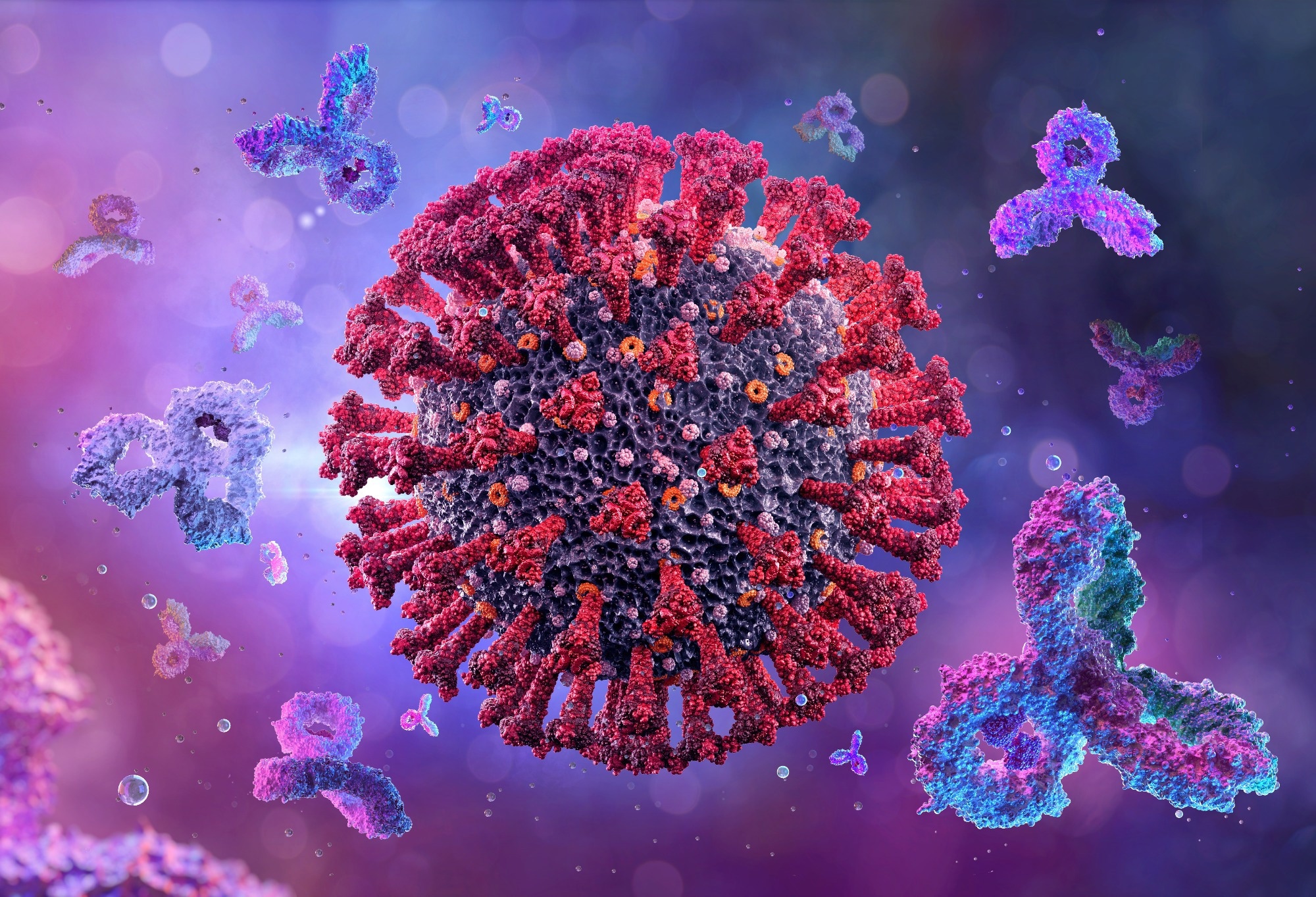In a recent study posted to the bioRxiv* preprint server, an international team of researchers leveraged the human light chain apoferritin protomer-derived MULTI-specific, multi-Affinity antibody (Multabody, MB) platform for the generation of broad and potent SARS-CoV-2 (severe acute respiratory syndrome coronavirus 2)-neutralizing antibodies (Abs).
The continual emergence of SARS-CoV-2 variants of concern (VOCs) has threatened the efficacy of anti-SARS-CoV-2 therapeutic monoclonal antibodies (mAbs). The study's authors previously developed the MB platform to enhance the neutralization ability of anti-SARS-CoV-2 and anti-human immunodeficiency virus 1 (HIV-1) Abs. In addition, they reported that increased Ab affinity could be combined with multi-specificity (multiple Ab fragments that recognize different epitopes) to improve antigen recognition.
 Study: Antibody avidity and multi-specificity combined to confer protection against SARS-CoV-2 and resilience against viral escape. Image Credit: Corona Borealis Studio / Shutterstock
Study: Antibody avidity and multi-specificity combined to confer protection against SARS-CoV-2 and resilience against viral escape. Image Credit: Corona Borealis Studio / Shutterstock
About the study
In the present study, researchers investigated whether the previously enhanced in vitro SARS-CoV-2 neutralization reported for the MB platform could translate into in vivo protection at low dosages. They also investigated whether the MBs could recover the neutralization ability loss observed for conventionally used mAbs against SARS-CoV-2 VOCs and expand their breadth of action to other viruses.
The tri-specific MB was assembled with atom-level resolution and examined by cryo-electron microscopy (cryo-EM) analysis. The MB's ability to provide immune protection in vivo was assessed by using generating an IgG cocktail corresponding to the MB comprising IgG4 Fc mutations (F234A, S228P, G237A, P238S, L235A) to eliminate binding with Fc-gamma receptors (FcgRs). Biolayer interferometry (BLI) experiments and ADCP (Ab-dependent cell-mediated phagocytosis) experiments were performed.
Human angiotensin-converting enzyme 2 (hACE2)- and hFcRn-expressing mice were treated with FcgR binding-deficient MB and IgG4 molecules and intranasally challenged with SARS-CoV-2. Mice lung samples were obtained to determine pulmonary viral titers based on their cytopathic effects (CPE) and quantitative reverse transcription-polymerase chain reaction (qRT-PCR) analysis.
To investigate whether the neutralization potency of the mAbs could be improved further, mono-specific MBs were expressed, and their neutralization breadth and ability were compared to their corresponding mAbs against SARS-CoV-2 wildtype (WT) strain and VOCs Alpha, Beta, Gamma, Delta, and Omicron BA.1.
Pseudovirus (PsV) neutralization assays and sarbecovirus neuralization assays were performed to determine the neutralization titers. Further, the molecular binding mechanisms of mAb 80 were explored.
The tri-specific 2-7-10-40-11-11 molecular coverage was evaluated based on the individual and combined RBD buried surface area (BSA) of Ab specificities exhibited by their three-dimensional (3D) structures. Human embryonic kidney (HEK) 293T-ACE2 cells and Vero E6 cells were used for cell culture experiments, and genes encoding human apoferritin fusions, fragment antigen-binding regions (Fabs), fragment crystallizable regions (Fcs), and IgGs were expressed in the HEK 293F cells. The protein fractions were purified by chromatography, and flow cytometry (FC) analysis was performed.
Results
The Ab-like molecule cores were homogeneous. Neutralization potency MB improvements translated into improved in vivo immune protection at doses 30x lower than the corresponding IgGs. MBs potently neutralized SARS-CoV-2 variants by utilizing combined avidity, and several mAbs could be amalgamated into one MB molecule (with 62 contact residues) to neutralize sarbecoviruses other than SARS-CoV-2.
The apoferritin MB scaffold resembled the human apoferritin light chain. The tri-specific MB (TMB) half-maximal inhibitory concentration (IC50) value was 0.0002 μg/mL, 1000-fold higher than the IgG cocktail. IgG4 Ab cocktail and the TMB were bound to murine and human FcRn but not to FcgRs. The TMB conferred significantly higher protection (60% survival) than the IgG4 Ab cocktail.
Five mAbs (80, 52, 80, 11-11, 10-40 and 2-36) showed 100% breadth with an IC50 cut-off value of five μg/mL. However, when using an IC50 cut-off value of 0.01 μg/mL, only 11-11 and 10-40 neutralized two VOCs. On the contrary, when used as mono-specific MBs, three mAb specificities (2-7, 80, and 52) attained 100% neutralization breadth using the same cut-off value.
The mAb 80 inhibited SARS-CoV-2 by preventing the receptor binding motif (RBM) interaction with ACE2, and the mAb's heavy chain and T478 and S477 residues were primarily responsible for the host-viral interactions. The residues were mutated in VOCs, reducing the Ab binding, which was increased by MB. Likewise, mutations reduced SARS-CoV-2 VOC and other sarbecovirus neutralization by mAbs 2-7, 10-40, and 11-11 incorporated into the tri-specific molecule, which was restored by the higher BSA covering-MB.
Overall, the study findings showed that by targeting three incompletely overlapping functional RBD epitopes and via neutralization potency gains by avidity, the tri-specific 2-7-10-40-11-11 MB provided proof-of-concept for broad, resilient, and potent pan-sarbecovirus neutralization as one molecule.
*Important notice
bioRxiv publishes preliminary scientific reports that are not peer-reviewed and, therefore, should not be regarded as conclusive, guide clinical practice/health-related behavior, or treated as established information.
- Antibody avidity and multi-specificity combined confer protection against SARS-CoV-2 and resilience against viral escape. Clare Burn Aschner et al. bioRxiv preprint 2022, DOI: https://doi.org/10.1101/2022.10.23.513379, https://www.biorxiv.org/content/10.1101/2022.10.23.513379v1
Posted in: Medical Science News | Medical Research News | Disease/Infection News
Tags: ACE2, Angiotensin, Angiotensin-Converting Enzyme 2, Antibodies, Antibody, Antigen, Cell, Cell Culture, Chromatography, Coronavirus, Coronavirus Disease COVID-19, Cytometry, Efficacy, Electron, Electron Microscopy, Enzyme, FcRn, Flow Cytometry, Genes, HIV, HIV-1, Immunodeficiency, in vitro, in vivo, Kidney, Microscopy, Molecule, Omicron, Phagocytosis, Polymerase, Polymerase Chain Reaction, Protein, Pseudovirus, Receptor, Respiratory, SARS, SARS-CoV-2, Severe Acute Respiratory, Severe Acute Respiratory Syndrome, Syndrome, Transcription, Virus

Written by
Pooja Toshniwal Paharia
Dr. based clinical-radiological diagnosis and management of oral lesions and conditions and associated maxillofacial disorders.
Source: Read Full Article